Old Maps of Brazil
Take a look into our vast collection of Old Maps of Brazil.
Brazil is located in South America, and is the largest country within South America and Latin America, with an area of 8.5 million square kilometers (3.3 million square miles) and a population of over 211 million inhabitants. This also makes Brazil the sixth most populated country in the world, as well as the fifth-largest country by area in the world. Immigration plays a key role in the large growth of Brazil, and because of this, Brazil is one of the most multiethnic and diverse countries in the world. The capital is Brasília, and the most populated city is São Paulo. Because of its large size, Brazil shares a border with every South American country with the exceptions of Ecuador and Chile. The country is so large it takes up about half of the entire continent of South America’s land!
The climate of Brazil is greatly varied due to its large size. Within Brazil, there are six major climatic subtypes, and they are as follows: desert, equatorial, tropical, semiarid, oceanic, and subtropical. Many regions within Brazil have vastly different microclimates. Similar to the climates found within the country, the land itself varies, with many highlands and lowlands. The highest peak within Brazil is Pico de Neblina, with an altitude of around 9,827 feet above sea level. The lowest point would clearly be the Atlantic Ocean, sitting at sea level.
Brazil is home to the Amazon Rainforest, which is globally recognized as having some of the largest biodiversity in the world. In fact, the average acre of land within the Amazon Rainforest includes over 250 different species of trees. Within the water of the rainforest, dolphins, over 1,500 species of fish, and over 450 species of catfish can be found. The world’s largest freshwater turtle, the yellow-headed sideneck, calls the Amazon its home. Sadly, with this great biodiversity and large amounts of land, many animals within the Amazon are endangered, such as the yellow-headed sideneck. These animals are illegally hunted for their meat, and plants and trees are destroyed to make room for humans to reside.
The Rio carnival is the most famous example of Brazilian culture. The carnival serves as both a religious holiday, as well as an honoring of African ancestry. During the celebrations in Rio de Janeiro, neighborhoods are decorated with bright lights and streamers and live music and dance can be found everywhere. Following up to the carnival, many take their leisure time into preparing for the activities and contests that occur during the six day event.
Currently, Brazil stands as the largest economy within Latin America, as well as ranking as the world’s ninth largest economy. Brazil is home to a mixed economy due to the amount of natural resources found within the country. Did you know that for the last 150 years, Brazil has been the number one producer of coffee? Brazil is also one of the world’s largest iron extractors, as well as one of the largest producers of animal proteins.
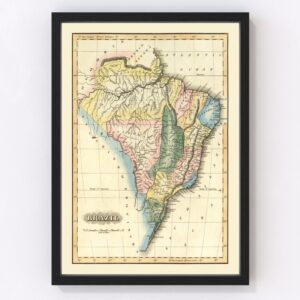
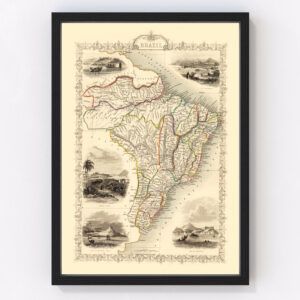


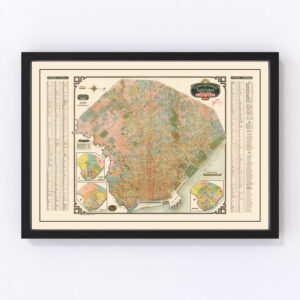

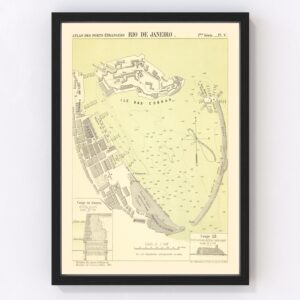

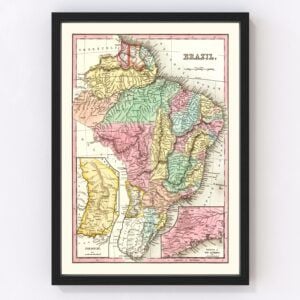
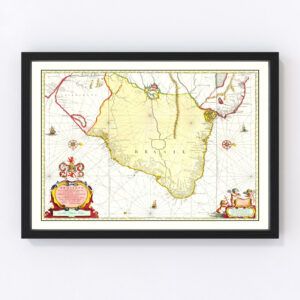

Old Maps of Brazil
Take a look into our vast collection of Old Maps of Brazil.
Brazil is located in South America, and is the largest country within South America and Latin America, with an area of 8.5 million square kilometers (3.3 million square miles) and a population of over 211 million inhabitants. This also makes Brazil the sixth most populated country in the world, as well as the fifth-largest country by area in the world. Immigration plays a key role in the large growth of Brazil, and because of this, Brazil is one of the most multiethnic and diverse countries in the world. The capital is Brasília, and the most populated city is São Paulo. Because of its large size, Brazil shares a border with every South American country with the exceptions of Ecuador and Chile. The country is so large it takes up about half of the entire continent of South America’s land!
The climate of Brazil is greatly varied due to its large size. Within Brazil, there are six major climatic subtypes, and they are as follows: desert, equatorial, tropical, semiarid, oceanic, and subtropical. Many regions within Brazil have vastly different microclimates. Similar to the climates found within the country, the land itself varies, with many highlands and lowlands. The highest peak within Brazil is Pico de Neblina, with an altitude of around 9,827 feet above sea level. The lowest point would clearly be the Atlantic Ocean, sitting at sea level.
Brazil is home to the Amazon Rainforest, which is globally recognized as having some of the largest biodiversity in the world. In fact, the average acre of land within the Amazon Rainforest includes over 250 different species of trees. Within the water of the rainforest, dolphins, over 1,500 species of fish, and over 450 species of catfish can be found. The world’s largest freshwater turtle, the yellow-headed sideneck, calls the Amazon its home. Sadly, with this great biodiversity and large amounts of land, many animals within the Amazon are endangered, such as the yellow-headed sideneck. These animals are illegally hunted for their meat, and plants and trees are destroyed to make room for humans to reside.
The Rio carnival is the most famous example of Brazilian culture. The carnival serves as both a religious holiday, as well as an honoring of African ancestry. During the celebrations in Rio de Janeiro, neighborhoods are decorated with bright lights and streamers and live music and dance can be found everywhere. Following up to the carnival, many take their leisure time into preparing for the activities and contests that occur during the six day event.
Currently, Brazil stands as the largest economy within Latin America, as well as ranking as the world’s ninth largest economy. Brazil is home to a mixed economy due to the amount of natural resources found within the country. Did you know that for the last 150 years, Brazil has been the number one producer of coffee? Brazil is also one of the world’s largest iron extractors, as well as one of the largest producers of animal proteins.
